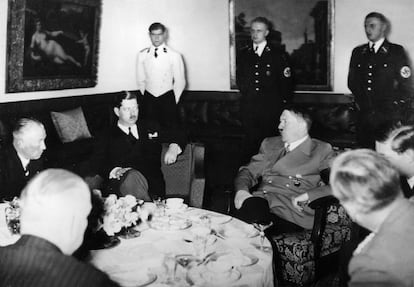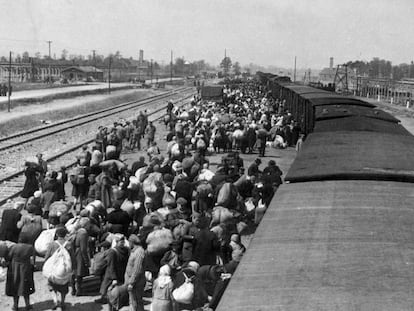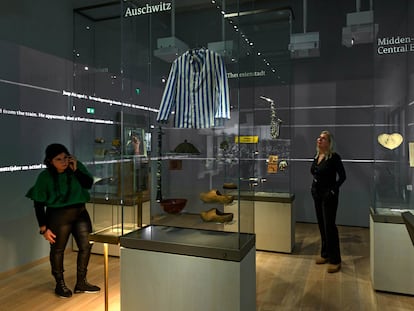Romania breaks its Holocaust taboo with a specific subject at school
Since last September, Romanian high school students have been obliged to learn about the role their country played in the extermination of Jews, Roma people, individuals living with disabilities and other targeted groups. According to the prime minister, this is to face ‘the dark side’ of the country’s history

In 1944, Livia and Heidi — two twins from Sighetu Marmației, a Transylvanian city located in northwestern Romania — were deported with their family from the ghetto to the Auschwitz concentration camp, in Nazi-occupied Poland. There, a doctor was waiting for them to carry out atrocious experiments, with the aim of achieving multiple births of Aryan children. The two sisters miraculously survived. With the Allied advance, they were transferred to Bergen Belsen — located in present-day Germany — until their liberation. Livia, 97-years-old, still lives to narrate her ordeal.
Darius Bogeag is a student in a new course titled History of the Jews, taught by the Matei Basarab National College, a high school in the Romanian capital of Bucharest. He tells EL PAÍS the grim story of the Frankel sisters because of the emotional impact it has had on him, after listening to Livia’s testimony.
Romania — which decimated the country’s Jewish community for decades, before, during and after the Holocaust — has been teaching about the Holocaust for one hour a week in its secondary schools on a mandatory basis since September 2023. This period of history was long banned from the curriculum in this Eastern European country. “The testimonies overwhelm us and help us understand what happened and what’s happening in today’s world,” emphasizes 17-year-old Darius. For his classmate, Petru Ivanel, “the subject aims to deconstruct what happened [so that we can] learn from such a terrifying moment in our history to prevent it from happening again.” They study the history of the Jews in Europe, from Antiquity to World War II, and also take time to comment on the most recent events, such as the Hamas attack in Israel on October 7, 2023.
Above all, Romanian students analyze the cruel acts perpetrated by torturers during the Holocaust, as well as the testimonies of those who suffered them. “I was surprised how, for more than 2,000 years, there were antisemitic proclamations without any logic, which already anticipated what would come later,” Darius notes.
“You leave the course deeply disappointed with the attitude that people had almost 85 years ago. They could have done much more to save human lives from barbarism,” laments Victor Corbaeanu, also a student at this school, who is struck by the fact that his country had numerous famous historical figures of Jewish origin.
The Romanian authorities — allied with Nazi Germany until 1944 — killed between 280,000 and 380,000 Romanian and Ukrainian Jews during the deadliest war of the last century. According to historians, these particular massacres took place in territories controlled by the fascist regime of Marshal Ion Antonescu. Added to these exterminations was the decision made by the subsequent communist dictatorship (1947-1989) to allow for the emigration of Jews in the mid-1950s, in exchange for livestock and agricultural materials. The Jewish population of Romania has fallen dramatically over the past century, from 800,000 people in the late-1930s — the third-largest community in Europe — to around just 3,000 today.
Although the recent history of communism still persists in the lively debate among citizens, for years, the Romanian authorities have denied what is known as the “Romanian Holocaust.” Even Antonescu, who was sentenced to death for war crimes and executed in 1946, is still considered a hero by many.
Iuliana Caplescu — a history teacher at the Matei Basarab National College — is satisfied with the government’s initiative against the “resurgence of antisemitic and neo-fascist movements” in Europe. “It’s a unique opportunity for students to understand that extremely serious events carried out by individuals against others have occurred,” explains this teacher, who has more than 25 years of experience in the classroom. She’s been overwhelmed by the avalanche of questions, stemming both from the students’ interest and the limited materials she has available to offer them.
“There are no professionals trained in what the Holocaust means, so we must be very careful with what we transmit,” Caplescu continues, while urging Romania to accept the mistakes of the past. “It’s a challenge both for the students — who we teach through testimonies — and for the teachers, some of whom are reluctant to teach the subject, even though they don’t express it openly,” emphasizes Mirela Alexandrescu, also a teacher.
Caplescu explains that the peak of the genocide occurred between 1941 and 1942, when Adolf Hitler offered the territory of Transnistria — currently a breakaway state within the border of Moldova — to the government in Bucharest. Deportations were carried out en masse to this former Soviet enclave, where it’s estimated that over 30,000 Roma people perished, in addition to approximately 100,000 Jews. Today, these facts are finally taught in Romania, the only country in the European Union where the Holocaust is explicitly studied as its own subject within the General History curriculum.
“We want to convey to the students what it means to live in a democratic society,” says Mihai Mahnea, an inspector at the Bucharest Department of Education. “The country’s extreme-right takes advantage of ignorance about the Romanian Holocaust to claim that Antonescu saved Jewish [and Roma] lives by opposing [the order from Berlin] to send them to extermination camps, which is a big lie,” he asserts. “Few have heard about the pogroms, which took the lives of thousands of people,” Mahnea continues.
Antisemitic acts
Romania has recorded an increase in incidents against Jewish people over the last decade. The Prosecutor General’s Office counted 51 acts of this type in 2022, compared to six in 2012. And, in the city of Iași, in northwestern Romania, an immense Jewish cemetery shows the extent of the massacre. Half of the city’s population — about 150,000 in the early 1940s — belonged to the Jewish minority. In a pogrom which took place in June 1941, thousands of them were murdered, while many others were crammed into freight cars — known as death trains — where the ventilation holes were covered. Amidst stifling heat and without water, most died of asphyxiation.
Iași has had a memorial museum since 2021, which has seen a notable increase in visits since the Holocaust began being taught in Romanian schools. “With the course, we can teach students about discrimination and antisemitic manifestations, combat stereotypes and [foster] positive attitudes towards ethnic minorities,” notes Cristina Talpan, who teaches History at the Dimitrie Cantemir Institute in Iasi. She believes, however, that this is a niche discipline and shouldn’t be mandatory. “All minorities in Romania could claim that their histories should also be studied,” the educator opines. However, she appreciates the political motivations behind the compulsory nature of this subject.
For Prime Minister Marcel Ciolacu, making the teaching of this period mandatory is a part of “facing the dark side” of the country’s history. According to a survey of around 1,300 Romanians carried out at the end of 2023 by the Elie Wiesel Center, only 11% say that they know about Romania’s role during the Holocaust. Ana Barbulescu — the research coordinator of this center, which is dedicated to the study of the Holocaust in Romania — attributes this lack of knowledge to the fact that the subject had never been taught in schools. She also blames false notions of patriotism, which attempt to prevent the population from believing that these events took place in the country. “Just because there were no gas chambers within Romanian territory doesn’t mean that the Holocaust didn’t exist in Romania,” the researcher points out.
The far-right Alliance for the Union of Romanians (AUR) — a political party which entered the Parliament in the 2020 elections — is now rising in the polls ahead of the December elections this year. This party has opposed explaining Romania’s role in the Holocaust. Its leader defines it as “a minor issue,” a statement that has sparked harsh criticism. “Romania must recognize that it’s the main culprit of the mass death of [Romanian] Jews and Roma,” Barbulescu affirms.
Sign up for our weekly newsletter to get more English-language news coverage from EL PAÍS USA Edition









































